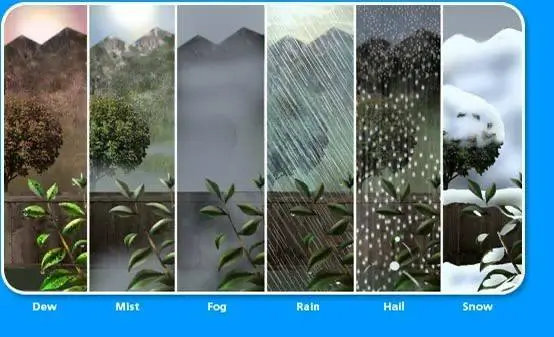What is the difference between Fog, Mist and Dew?
Fog is a cloud that appears near the ground or touches the ground. Mist is a thin fog that appears near the ground. Dew is deposit of water drops that is formed on cold surfaces by condensation of water vapors in the air.
Fog, mist and dew seem to be interrelated and often create confusion when one tries to define them. There is a little difference between fog and mist. Dew basically differs in the phenomenon pertaining to its formation.
Fog is a thick cloud that remains suspended in the atmosphere or near the surface of the Earth. Due to fog, visibility is greatly affected and it remains restricted and obscured.
To describe fog, one must be familiar with the term cloud. Cloud is a visible accumulation of tiny water droplets or ice crystals that are formed in the atmosphere of the Earth. You might have seen clouds; they vary in size, shape and color. The white appearance of cloud is due to a tight packed arrangement of water droplets in its structure.
Air, when filled with water vapor generates the clouds. Thus, fog can be simply termed as a cloud that touches the surface of the Earth. Water vapor or gas is invisible, but still one can see fog, due to the presence of water droplets in it.
Mist is same as fog; it is just less dense than fog. Fog tends to be thicker and massive than mist. Thus, both can be defined as the clouds that touch the Earth. The only difference between them is regarding the density. A fog that is thinner than mist is known as haze. Fog can also turn acidic, if tiny liquid droplets combine with gaseous impurities, such as oxides of sulfur and nitrogen.
Dew is condensed moisture that appears in the form of small drops and is found on a relatively cold surface. Radiation is responsible for cooling the objects near the Earth’s surface more rapidly. Therefore, the ground objects become cooler in comparison to the surrounding air. When this air contacts a colder surface, it cools down by the process of conduction. In the same process, it loses its ability to hold water vapors. This cooled air generates tiny droplets of condensed water vapor. They are generally found on the twigs, leaves and blades of grass. It is a major source to provide moisture to the plants. Dew, generally appears in early morning or in evening. If the temperature cools down further, then dew freezes and becomes ice, known as frost. On the other hand, mist and fog usually form at night, as the air becomes too cold to hold all its moisture.
कोहरा, धुंध और ओस में क्या अंतर है?
कोहरा एक बादल है जो जमीन के करीब दिखाई देता है या जमीन को छूता है। धुंध एक पतला कोहरा है जो जमीन के पास दिखाई देता है। ओस पानी की बूंदों का जमाव है जो हवा में जलवाष्प के संघनन से ठंडी सतहों पर बनता है।
ऐसा प्रतीत होता है कि कोहरा, धुंध और ओस आपस में जुड़े हुए हैं और जब कोई उन्हें परिभाषित करने का प्रयास करता है तो अक्सर भ्रम पैदा होता है। कोहरे और धुंध में थोड़ा अंतर होता है. ओस मूल रूप से इसके गठन से संबंधित घटना में भिन्न होती है।
कोहरा एक घना बादल है जो वायुमंडल में या पृथ्वी की सतह के निकट लटका रहता है। कोहरे के कारण दृश्यता काफी प्रभावित होती है और यह प्रतिबंधित एवं अस्पष्ट रहती है।
कोहरे का वर्णन करने के लिए, किसी को बादल शब्द से परिचित होना चाहिए। बादल पानी की छोटी बूंदों या बर्फ के क्रिस्टल का एक दृश्य संचय है जो पृथ्वी के वायुमंडल में बनता है। आपने बादल देखे होंगे; वे आकार, आकार और रंग में भिन्न होते हैं। बादल का सफेद दिखना उसकी संरचना में पानी की बूंदों की सघन व्यवस्था के कारण होता है।
वायु, जब जलवाष्प से भर जाती है तो बादल उत्पन्न करती है। इस प्रकार, कोहरे को केवल एक बादल कहा जा सकता है जो पृथ्वी की सतह को छूता है। जलवाष्प या गैस अदृश्य है, लेकिन फिर भी पानी की बूंदों की उपस्थिति के कारण कोहरा देखा जा सकता है।
धुंध कोहरे के समान है; यह कोहरे से कम घना है। कोहरा, धुंध की तुलना में अधिक घना और विशाल होता है। इस प्रकार, दोनों को पृथ्वी को छूने वाले बादलों के रूप में परिभाषित किया जा सकता है। इनके बीच एकमात्र अंतर घनत्व को लेकर है। कोहरा जो कोहरे से भी पतला होता है उसे धुंध कहा जाता है। यदि छोटी तरल बूंदें गैसीय अशुद्धियों, जैसे सल्फर और नाइट्रोजन के ऑक्साइड के साथ मिल जाती हैं, तो कोहरा अम्लीय भी हो सकता है।
ओस संघनित नमी है जो छोटी बूंदों के रूप में प्रकट होती है और अपेक्षाकृत ठंडी सतह पर पाई जाती है। विकिरण पृथ्वी की सतह के पास की वस्तुओं को अधिक तेजी से ठंडा करने के लिए जिम्मेदार है। इसलिए, ज़मीन की वस्तुएं आसपास की हवा की तुलना में ठंडी हो जाती हैं। जब यह वायु किसी ठंडी सतह के संपर्क में आती है तो चालन की प्रक्रिया द्वारा ठंडी हो जाती है। इसी प्रक्रिया में, यह जलवाष्प धारण करने की अपनी क्षमता खो देता है। यह ठंडी हवा संघनित जलवाष्प की छोटी बूंदें उत्पन्न करती है। वे आम तौर पर टहनियों, पत्तियों और घास के पत्तों पर पाए जाते हैं। यह पौधों को नमी प्रदान करने का एक प्रमुख स्रोत है। ओस, आमतौर पर सुबह या शाम को दिखाई देती है। यदि तापमान और अधिक ठंडा हो जाता है, तो ओस जम जाती है और बर्फ बन जाती है, जिसे पाला कहा जाता है। दूसरी ओर, धुंध और कोहरा आमतौर पर रात में बनता है, क्योंकि हवा अपनी सारी नमी को बनाए रखने के लिए बहुत ठंडी हो जाती है।




